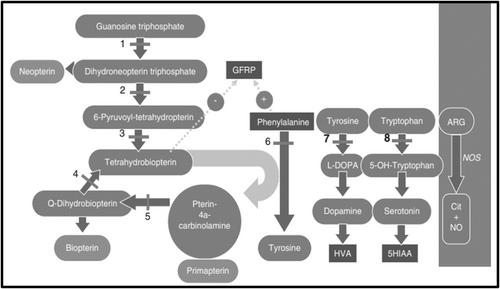A Single-Center Retrospective Cohort Study of Biopterin Metabolism Disorders in the United Arab Emirates
Abstract
Background
Tetrahydrobiopterin (BH4) deficiencies comprise a group of five neurometabolic disorders caused by five genetic defects responsible for BH4 biosynthesis and regeneration. Their global prevalence remains unknown, and variance exists among different countries.
Aims
To describe clinical, biochemical, molecular genetic data and follow-up of patients with BH4 deficiency seen in Tawam Hospital.
Methods
A retrospective study of all patients with BH4 disorders who were followed up between January 2010 and December 2023 in Tawam Hospital. All data were retrieved from patients' electronic charts, including baseline characteristics, developmental milestones, family history, and clinical examination. Radiological and laboratory investigations, including phenylalanine levels, prolactin levels, CSF study, urine and plasma pterin profiles, and molecular tests, were reviewed.
Results
Ten patients with BH4 deficiencies were found. The youngest patient was diagnosed at 3- weeks, and the oldest was nine; 70% were male, consanguineous 80%, and 40% were Emirati. Prematurity was reported in two patients. Intrauterine growth restriction was found in 70%, and microcephaly in 40%. Eighty percent had developmental delay, and 2 patients had behavioral issues. Seizure and movement disorders were reported in five and three patients, respectively. Brain MRI showed cortical atrophic changes, corpus callosum hypoplasia, hyperintensities in the parieto-occipital region, and periventricular white matter. Abnormal Newborn screening was found in 60%, with initial high phenylalanine levels (>120 μmol/L) in 80%. Prolactin level was high in all studied patients. Four patients' cerebrospinal fluid neurotransmitter metabolites were evaluated. Blood for DHPR screening and urine pterin profile were done on eight patients. Nine patients had molecular testing. DHPR deficiency was most commonly reported among studied patients (50%), with five novel variants in the QDPR gene. The second prevalent disorder was PTPS deficiency and only one patient with SR deficiency.
Conclusion
This cohort offers an in-depth clinical and genetic understanding of BH4 deficiencies from a single center in the UAE. It describes new genetic variants and addresses diagnostic challenges to enhance the patient's diagnosis and treatment.


 求助内容:
求助内容: 应助结果提醒方式:
应助结果提醒方式:


